Latest News
February 1, 2007
By DE Editors
Let There Be Light Tools 5.4
Enhanced modeling, optimization capabilities highlight new release.
The newest release of the illumination design and analysis software from Optical Research Associates (ORA; Pasadena, CA), Light tools 5.4 is said to have been enhanced with new capabilities for modeling surface textures and a number of improvements to its optimization engine.
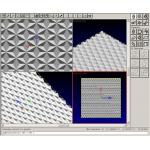 |
| LightTools 5.4 |
Light tools Version 5.4 introduces a surface-texture feature that lets you create an arbitrary geometrical object and then produce surfaces in which the object is positioned repeatedly in a variable pattern. According to ORA, you can move, rotate, and scale the texture objects within your pattern individually. Additionally, you can refine these parameters automatically using the Light tools Optimization Module, a modeling and optimization capability said to be particularly useful for designing critical components of LCD back lights, micro lens arrays,digital micro mirror device (DMD) projection systems, and light pipe components.
ORA also cites two new merit functions in Light tools 5.4 that enhance the Light tools Optimization Module for many common illumination applications. The first, the Focus Merit Function, is said to facilitate the optimization of optical system illuminance at a specified receiver location. The second, the Collimate Merit Function,makes it easier to maximize light intensity projected in a given direction.
Other improvements in Light tools 5.4 include new support for the CATIAV5 file format and refinements to the software’s optimization algorithms, which, the company says, can produce faster convergence results and increase your optimization solution success rate.
For further information on Light tools 5.4, click here.
COMSOL Multiphysics 3.3a Gets New Material Library
Product family runs on Vista, Intel-based Macs, accelerates CAD import.
COMSOL Inc. (Burlington, MA) has introduced COMSOL Multiphysics 3.3a,its multiphysics simulation environment, with a new material library that simplifies the specification of properties for more than 2,500materials. There’s also a CHEMKIN file-import facility to enable the reading of data in the standard chemical industry format for gas-phase reactions, combustion, and atmospheric chemistry. A new repair and defeaturing function makes it easy to refine geometry representations during the import of CAD files so users can model complex designs faster, and the entire product family now runs on Microsoft’s Vista OS as well as on Intel-based Macs.
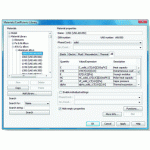 |
| COMSOL Multiphysics 3.3a |
The Material Library automates the process of specifying materials in a complex model. This optional product contains data on 2,500 materials including the elements, minerals, rocks, soil, metal alloys, oxides,steels, thermal insulators, semiconductors, and optical materials. For each one it supplies property functions for as many as 24 key properties. The properties can be used in everything from structural analyses to quasi-static simulations in electromagnetics, and they automatically account for thermal effects on properties once coupled to a thermal analysis. Materials can be identified by name or by UNS or DIN number. Property functions are user-modifiable, and properties and materials can be added.
The COMSOL Reaction Engineering Lab now reads kinetics, thermodynamic,and transport-description files in the widely used CHEMKIN format. The Reaction Engineering Lab can use the imported data to set up and solve mass and energy balances for ideal reactor systems and then turn to COMSOL Multiphysics to analyze them in real-world reactor geometries.
CAD Import Module 3.3a has added repairing and defeaturing of 3D CAD data. The repair feature makes it possible to remove imperfections to create solids and surfaces that are mathematically and physically correct. The CAD Import Module makes imported CAD data suitable for FEA by repairing geometry objects, knitting faces, and filling gaps, either automatically or interactively under user control.
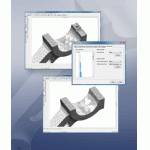 |
| COMSOL Multiphysics 3.3a |
The new defeaturing tools let users remove irrelevant details for a CAD model while retaining a model’s geometric integrity. Details can also be detached to create separate sub domains that represent separate parts in the finite-element model. To remove unnecessary details, users access tools that easily remove fillets, small faces, sliver faces, as well as spikes or short edges. The CAD Import Module is based on Parasolid geometry kernel and includes ACIS to support the SAT format.
COMSOL 3.3a now also includes support for MATLAB 2006b. COMSOL Multiphysics is available for $7,995 in a single-user license. The Material Library lists for $1,995. The COMSOL Reaction Engineering Lab sells for $3,495. The CAD Import Module sells for $1,995.
For more information, click here.
Dassault Releases New Fluid-Structure Interaction Analysis Solution
Collaboration uses ABAQUS and STAR-CD to deliver multiphysics.
Dassault Systemes (Paris, France) has announced a new fluid-structure interaction (FSI) solution using ABAQUS finite element analysis (FEA)software from its SIMULIA brand and STAR-CD, the computational fluid dynamics (CFD) software from CD-adapco (Melville, NY and London, UK).
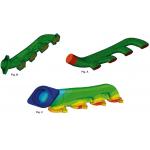 |
| Simulia |
The new FSI solution builds on the
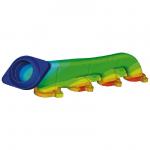 |
| Simulia |
SIMULIA strategy of delivering an open platform for multiphysics simulation. The bidirectional coupling leverages a partnership with CD-adapco as well as Fraunhofer SCAI(Sankt Augustin, Germany), which developed MpCCI coupling software, to enable ABAQUS and STAR-CD to work together to solve a range of FSI problems.
“Companies using our coupled solution will ... improve collaboration between fluid dynamics engineers and structural engineers, ” saidCD-adapco’s Dennis Nagy in prepared remarks. “This will enable them to gain a greater understanding of system behavior and a competitive edge in delivering innovative inventions and products.”
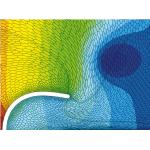 |
| Simulia |
“Multiphysics simulation such as FSI is increasingly important,” says Ken Short at SIMULIA. “It allows engineers to replicate and predict realistic physical behavior of complex systems where the interactions of fluid and structural responses are significant. Our customers will benefit tremendously from our open platform approach, which enables them to easily integrate, fully supported best-in-class technology.”
The new offering is intended to allow manufacturers and researchers in automotive, aerospace, off-shore, biomedical, consumer, and the process industries to study the influence of fluid flow-induced forces and heat transfer on structural integrity as well as the impact of nonlinear material response on fluid flow behavior. This allows them to evaluate a broad range of conditions, such as flow-induced vibrations in structures, in-vivo vascular flows, valve dynamics, and fluid-structure applications in consumer goods and packaging.
For more information, click here.
New Modeling Options in FLUENT 6.3
More than 100 new features broaden scope of widely deployed application.
ANSYS Corp. (Canonsburg, PA) says Version 6.3 of the FLUENT CFD has more than 100 new features broadening its capabilities in meshing moving objects, reacting flows, and multiphase flows.
The main focus of this release is on core solver improvements. A pressure-based coupled solver joins the existing solver options. Polyhedral meshes, new in FLUENT 6.3 software, allow the flexibility of an unstructured mesh to be applied to complex geometries. Additionally,improvements to parallel efficiency and flexibility have been implemented, including speed improvements for reading and writing case and data files.
With FLUENT 6.3 dynamic mesh capabilities for modeling moving objects,such as pistons and valves in combustion engines can now be applied to a series of related steady-state simulations. V6.3 also has been improved to work better with third-party CAE packages. For more details, click here.
To vote on your favorite product from this section as well as from among those in this month’s DE, click here.
Subscribe to our FREE magazine, FREE email newsletters or both!
Latest News
About the Author
DE’s editors contribute news and new product announcements to Digital Engineering.
Press releases may be sent to them via [email protected].






